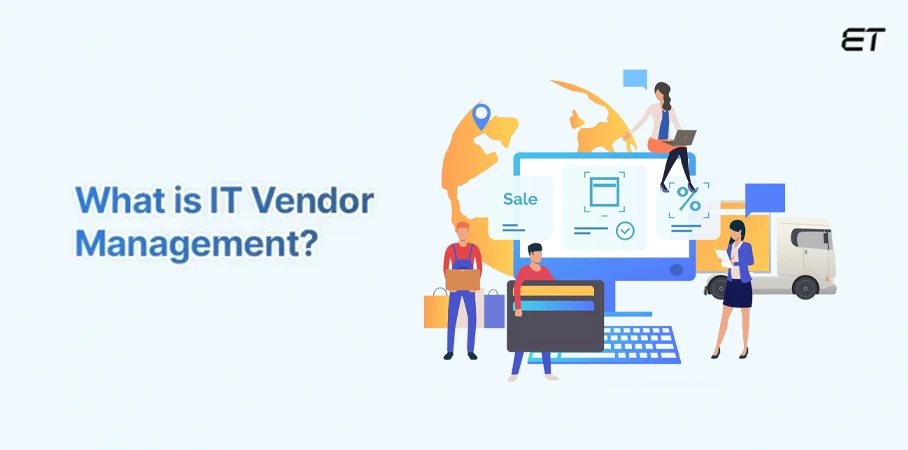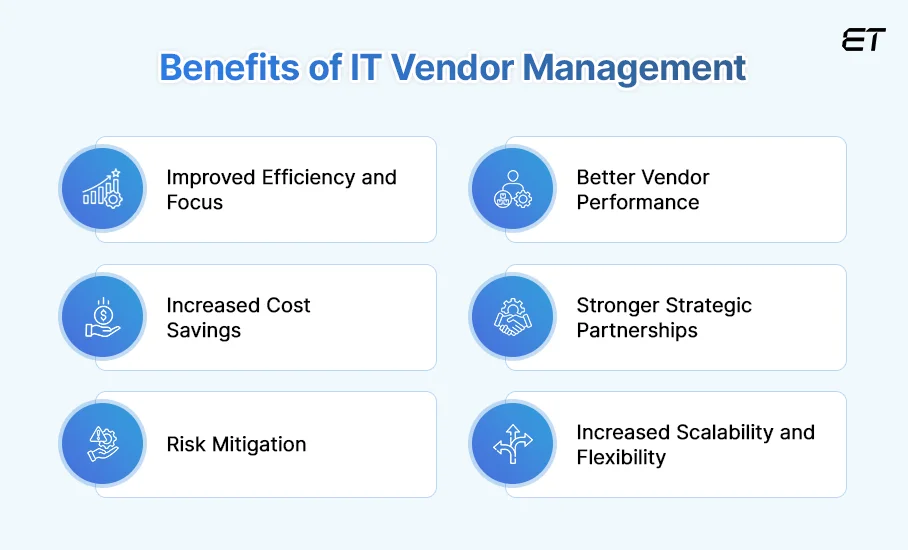
Your Guide to Smarter IT Vendor Management: Best Practices for Business Leaders
Visualize this – You want to build a house and have the best blueprint in hand but don’t have skilled workers or the right tools. Would you be able to make your house? No, because the entire project will fall apart, right? This is exactly what IT vendor management is like in today’s digital age. You might have the best business strategy and cutting-edge technology at your disposal, but without the right vendors supporting your operations, things can get complicated fast.
But here’s the catch – managing these vendors is no walk in the park. It’s not just about placing an order and hoping for the best. It’s about building strong, strategic partnerships that ensure your company stays agile, secure, and competitive. An effective vendor management process begins with robust vendor onboarding, which helps external partners understand the business context and specifics of the projects they are involved in. Whether it’s cloud services, cybersecurity solutions, or software development, how you manage your vendors can make or break your IT infrastructure.
In this blog, we’ll explore what IT vendor management means, why it’s crucial for your business and the best practices that will help you turn the IT vendor management process into a powerhouse for growth, efficiency, and innovation. Ready to turn your vendor relationships into a strategic advantage? Let’s get started.
What is IT Vendor Management?

In simple terms, IT vendor management involves overseeing and controlling your organization’s external IT suppliers. This includes everything from software providers to cloud hosting services. The goal? To maximize the value these vendors deliver while minimizing risks and costs. But there’s more to it than just signing contracts and paying bills. Effective IT vendor management means:
- Selecting the right vendors
- Constantly monitoring their performance
- Ensuring their services align with your business objectives.
Vendor management software plays a crucial role in improving budget optimization and operational efficiency. This ongoing process is part of the vendor management lifecycle, which emphasizes that managing vendor relationships requires continuous effort and strategy.
Ready to optimize your vendor relationships? Let our experts help you to unlock seamless vendor management.
Benefits of IT Vendor Management
Managing IT vendors effectively can feel like balancing multiple spinning plates, but the benefits are well worth the effort when done right. It will enable you to build strategic partnerships that drive innovation, reduce risks, and help you run your business more smoothly.
Let’s explore some of the benefits that come with mastering IT vendor management:

1. Improved Efficiency and Focus
By implementing strong IT vendor management best practices, you can streamline operations and reduce the time spent managing vendor-related issues. A well-managed vendor relationship allows your internal teams to focus on their core competencies without worrying about the technical details handled by the vendor. This increased efficiency means you can operate your business more smoothly and concentrate on strategic growth rather than constantly putting out fires.
2. Cost Savings
When vendors are adequately managed, it’s easier to keep costs under control. Effective IT vendor management allows you to monitor vendor performance, ensuring you get the value you paid for. Strong negotiation during contract renewals can help you lock in better pricing and terms. You can also avoid the hidden costs that arise from poor vendor performance, such as project delays or service disruptions, which can end up costing you more in the long run.
3. Risk Mitigation
Every vendor relationship comes with risks, from data breaches to compliance issues. With a solid IT vendor risk management plan in place, you can stay on top of these potential risks. Regularly monitoring vendors’ security practices, financial health, and regulatory compliance will allow you to catch issues early before they escalate into bigger problems. Proactive management to mitigate risk is essential for protecting your business from unforeseen disruptions. Vendor management software can help in centralizing compliance information for audits and streamlining communication and reporting processes.
4. Better Vendor Performance
One of the most significant advantages of effective IT vendor management is improved performance through performance management. When you set clear expectations, establish measurable performance indicators, and regularly review the outcomes, vendors are more likely to meet — and even exceed — their obligations. With this structured approach, you can ensure that your vendors deliver on time, within budget, and up to your quality standards.
5. Stronger Strategic Partnerships
Vendor relationships shouldn’t just be transactional — they should be strategic. By managing vendor relationships effectively, you build long-term partnerships that foster innovation and collaboration. A well-managed vendor relationship can lead to better deals, flexibility, and early access to new technologies. Treating vendors as partners rather than mere service providers makes you more likely to work toward mutual success.
6. Scalability and Flexibility
As your business grows, so will your IT needs. A strong IT vendor management strategy ensures you can scale up or down as needed. Whether expanding into new markets, adopting new technologies, or increasing capacity, well-managed vendors can adapt quickly to your changing requirements, helping you remain agile and competitive in an ever-evolving market.
Challenges of IT Vendor Management
Managing IT vendors might sound simple at first – you hire a company, agree on terms, and they deliver the service. But in reality, IT vendor management is far more complex. It’s not just about keeping an eye on contracts and payments; it involves dealing with unpredictable challenges that, if not appropriately addressed, can cause severe disruptions to your business.
Let’s look at some of the most common challenges you can face during IT vendor management.

1. Lack of Visibility into Vendor Operations
One of the biggest hurdles in IT vendor management is not having full visibility into your vendor’s day-to-day operations. You depend on an external team, often based in different locations, to handle critical aspects of your IT infrastructure. Without a clear line of sight, tracking their performance, delivery timelines, or quality of work becomes tricky. This lack of transparency can lead to delays, miscommunication, and ultimately, service interruptions and failures that will have a significant negative impact on your business operations.
2. Managing Multiple Vendors
Businesses today often rely on multiple third party vendors to handle different parts of their IT ecosystem. While this might give you access to a variety of services and expertise, it also introduces the challenge of juggling multiple contracts, service levels, and communications. Each vendor has its own processes, timelines, and expectations, making it difficult to manage everyone cohesively. Without a proper IT vendor management strategy in place, you might find yourself in the middle of a chaotic mess.
3. Vendor Risk Management
Vendor risk is always on the table when you’re outsourcing critical IT functions. Data and security breaches, compliance issues, or financial instability on the vendor’s side could seriously harm your business. That’s where IT vendor risk management comes in. But managing these risks isn’t easy. You need to consistently monitor each vendor’s security protocols, compliance with regulations, and overall financial health. If you don’t, you could be blindsided by an unexpected problem you could have avoided with proactive management.
4. Cost Control and Contract Negotiation
Cost control is another tricky aspect of IT vendor management. While vendors are supposed to help you streamline operations and cut costs, you might find yourself overpaying for services that don’t meet your needs without proper oversight. Additionally, contract negotiation can be challenging, especially when dealing with larger vendors with rigid terms. Striking a balance between getting the best price and ensuring top-quality service is key, but it takes time, effort, and a deep understanding of your vendor’s capabilities and offerings.
5. Aligning Vendor Performance with Your Business Goals
Finally, one of the most significant challenges is ensuring that your vendor’s performance aligns with your business objectives. It’s easy for vendors to meet the basic contractual obligations, but are they helping your company grow and innovate? Ensuring your vendors understand and contribute to your long-term business goals requires ongoing communication, performance reviews, and, sometimes, challenging conversations about where improvements need to be made.
Looking to create software that fits your unique business needs like a glove? Our IT vendors specialize in building custom enterprise solutions that fit right for you.
How to Build a Strong IT Vendor Management Strategy?
A well-planned vendor management strategy is essential to ensure long-term success throughout the vendor partnership. It involves developing a comprehensive approach to managing vendors, defining vendor selection criteria, and identifying key areas of vendor management.
1. Developing a Vendor Management Strategy
Creating a robust vendor management strategy is the cornerstone of effective vendor management. Start by clearly defining your organization’s goals, objectives, and specific requirements for vendor management. This involves identifying the types of vendors you need, the services they will provide, and the outcomes you expect.
A comprehensive vendor management strategy should also outline the processes and procedures for managing vendors, from selection and contract negotiation to performance monitoring and management. By having a well-defined strategy, you can ensure that your vendor partnerships are aligned with your business goals and contribute to your overall success.
2. Defining Vendor Selection Criteria and Bid Document
Defining clear vendor selection criteria and creating a detailed bid document are critical steps in the vendor management process. Your selection criteria should encompass factors such as the vendor’s experience, expertise, and reputation, as well as their ability to meet your organization’s specific needs.
The bid document should clearly outline the scope of work, expected outcomes, and the evaluation criteria for selecting a vendor. This structured approach ensures that you choose vendors who are not only capable but also aligned with your business objectives, setting the stage for a successful partnership.
3. Identifying Key Areas of Vendor Management
Identifying key areas of vendor management is crucial for effectively managing your vendors and ensuring they meet their obligations. These areas typically include contract management, performance monitoring, risk management, and communication. By focusing on these critical aspects, you can develop strategies and processes that help manage vendors more effectively.
For instance, regular performance reviews and risk assessments can help you stay ahead of potential issues, while clear communication channels ensure that any concerns are addressed promptly. By honing in on these key areas, you can build stronger, more productive vendor relationships.
How to Select and Onboard a Vendor?
Vendor selection and onboarding are critical components of the IT vendor management process. A well-planned vendor selection process ensures that the chosen vendor meets the organization’s needs, while a smooth onboarding process sets the stage for a successful partnership.

1. Evaluating Potential Vendors
Evaluating potential vendors is a crucial first step in the vendor management process. This involves a thorough assessment of each vendor’s capabilities, experience, and reputation to ensure they can meet your organization’s specific needs. Key factors to consider during this evaluation include:
- Vendor Expertise and Experience: Look for vendors with a proven track record in your industry. Their experience can provide valuable insights and reduce the learning curve.
- Reputation and References: Check reviews, ask for references, and consider the vendor’s reputation in the market. A vendor with positive feedback from other clients is more likely to deliver quality service.
- Ability to Meet Specific Needs: Ensure the vendor can meet your unique requirements, whether it’s specialized software, cloud services, or cybersecurity solutions.
- Pricing and Cost Structure: Compare costs and ensure the vendor’s pricing aligns with your budget. Be wary of hidden fees and ensure transparency in their cost structure.
- Contract Terms and Conditions: Review the vendor’s contract terms to ensure they are favorable and protect your interests.
2. Creating a Vendor Matrix for Selection
A vendor matrix is an invaluable tool in the vendor management process. It allows you to systematically evaluate and compare potential vendors based on predefined criteria. This structured approach helps in making informed decisions. The matrix typically includes factors such as:
- Capabilities and Expertise: Rate each vendor based on their technical skills and industry knowledge.
- Experience and Reputation: Score vendors on their market reputation and client feedback.
- Pricing and Cost Structure: Compare the cost-effectiveness of each vendor.
- Contract Terms and Conditions: Evaluate the flexibility and fairness of contract terms.
- Ability to Meet Specific Needs: Assess how well each vendor can fulfill your unique requirements.
By using a vendor matrix, you can objectively compare vendors and select the one that best aligns with your business goals.
3. Onboarding New Vendors
Onboarding new vendors is a critical step in the IT vendor management process. Vendor onboarding is essential in streamlining the integration of new business partners, ensuring thorough preparation and effective vendor management. A smooth onboarding process ensures that the vendor is properly integrated into your organization’s systems and processes, setting the stage for a successful partnership. Key steps involved in onboarding new vendors include:
- Providing Necessary Documentation and Information: Ensure the vendor has all the information they need to get started, including access to relevant systems and documentation.
- Conducting Training and Orientation Sessions: Familiarize the vendor with your processes, tools, and expectations through comprehensive training sessions.
- Establishing Clear Communication Channels: Set up regular communication channels to facilitate ongoing dialogue and address any issues promptly.
- Defining Roles and Responsibilities: Clearly outline the roles and responsibilities of both parties to avoid any confusion.
- Setting Up Contract Management and Monitoring Processes: Implement systems to monitor the vendor’s performance and ensure compliance with contract terms.
Are you curious to learn about how IT vendors design enterprise software tailored just for you? Dive into our latest blog to discover about it in detail.
Contract and SLA Management
Contract and SLA (Service Level Agreement) management are essential components of the IT vendor management process. A well-managed contract and SLA ensure that the vendor meets the organization’s expectations and provides the required level of service.
Negotiating contract terms and conditions is a critical step in the IT vendor management process. A well-negotiated contract ensures that the organization’s interests are protected and that the vendor is held accountable for their performance. Key factors to consider during contract negotiation include:
- Scope of Work and Deliverables: Clearly define the scope of work and expected deliverables to avoid any misunderstandings.
- Pricing and Payment Terms: Ensure the pricing is transparent and aligns with your budget. Define payment terms that are fair and manageable.
- Contract Duration and Renewal Options: Set a reasonable contract duration with options for renewal based on performance.
- Termination Clauses and Penalties: Include clauses that allow for contract termination in case of non-performance, along with penalties for breaches.
- Service Level Agreements and Performance Metrics: Establish SLAs that define the expected level of service and performance metrics to measure the vendor’s performance.
By carefully negotiating contract terms and conditions, organizations can ensure that they get the best possible deal from their vendors, protecting their interests and ensuring high-quality service delivery.
Best Practices for IT Vendor Management
Effective IT vendor management best practices start with a proactive, organized approach. Here’s how you can implement strategies that ensure your vendor partnerships are successful:

#1 IT Vendor Management is more than just cost, so select the right vendor.
Knowing exactly what you need is crucial before you engage with potential vendors. Make sure to define your technical, operational, and strategic requirements upfront. This helps you choose vendors that align with your business goals. Don’t just focus on cost—look at factors like flexibility, scalability, and innovation. The clearer you are about your needs, the easier it will be to find the right fit and avoid miscommunication down the road.
#2 Want to stay on top of your KPI? Monitor vendor performance regularly.
Once you’ve selected a vendor, the next step is monitoring vendor performance to track their effectiveness. Setting up Key Performance Indicators (KPIs) is essential to ensuring your vendor is delivering on their promises. Common metrics might include service uptime, response times, or project deadlines. Regularly measuring these KPIs will give you concrete data to gauge the vendor’s performance. This approach will make it easier for you to spot potential issues early and address them before they become bigger problems.
#3 Manage IT vendor risk proactively, and don’t let your guard down.
Risk is inevitable in outsourcing, but with an effective IT vendor management plan, you can minimize the potential downsides. It’s important to assess third party vendors for data security issues, protection, compliance, and financial stability risks. It would help if you considered conducting regular risk assessments and audits as a part of your ongoing vendor management process. You can protect your business from costly disruptions and compliance violations by staying ahead of potential threats.
#4 Streamline your process by leveraging technology.
Managing multiple vendors manually can be time-consuming and prone to errors. So, what do you do in such situations? Well, you should play it smart here. Instead of managing everything manually, you can leverage Vendor Management Systems (VMS). These platforms assist you in automating contract and performance management, and conducting risk assessments. This will free up your time and reduce errors. In a study done by Forrester, they saw that businesses implementing VMS could see a 30% reduction in their administrative workload.
#5 Develop strong vendor relationships that are more than just transactions.
Good communication is the foundation of any successful relationship, as is in this scenario. Don’t wait until something goes wrong to check in with your vendor. You should schedule regular meetings to discuss progress, address concerns, and ensure the vendor understands your needs as time requires. This ongoing dialogue fosters transparency and helps build a stronger, more collaborative relationship. When vendors feel like they’re a part of your team, they’re more likely to go above and beyond to meet your expectations.
How Do You Align IT Vendor Management with Your Business Strategy?
When it comes to IT vendor management, it’s easy to focus on the day-to-day tasks: contracts, deadlines, and performance metrics. But there’s a bigger picture here—your vendors should be helping you achieve your long-term business goals, not just fulfilling short-term needs. Therefore, aligning IT vendor management with your business strategy and bringing them on the same as you is crucial.
But how do you do that? Let’s understand it below:

Step 1 — Start with a Clear Understanding of Your Business Goals
Knowing where your business is headed is essential before you even begin working with a vendor. What are your strategic goals for the next 2-5 years? Are you planning to expand into new markets, adopt new technologies, or improve customer service? Once you have a clear understanding of your objectives, you can start looking for vendors that not only meet your current needs but also have the potential to support your future ambitions.
Step 2 — Choose Vendors That Align with Your Vision
Not every vendor is a perfect fit for your business strategy, and understanding this as soon as possible will benefit your business. While a vendor might offer a great price or a fast turnaround, you need to assess whether they align with your long-term vision. Vendors that understand your industry and are flexible enough to grow with you will provide more value in the long run. Look for vendors that share your commitment to innovation, agility, and continuous improvement.
Step 3 — Integrate Vendors into Your Strategic Planning
Once you’ve selected the right vendors, the next step is to integrate them into your strategic planning process. This doesn’t mean giving them a seat at your board meetings but ensuring they understand how their services contribute to your broader goals. You can ensure this by regularly communicating your business objectives with your vendors and discussing how their roles can evolve as your strategy changes.
Step 4 — Focus on Long-Term Value, Not Short-Term Wins
It’s easy to get caught up in short-term gains like cost savings or quick deliveries, but when you align IT vendor management with your business strategy, the focus should shift to long-term value. This means fostering relationships with vendors willing to invest in your success over time. For example, a vendor that helps you adopt new technologies or offers flexibility in scaling services as your business grows is worth far more than one that meets the bare minimum today.
Step 5 — Continuously Review Vendor Contributions to Business Goals
Aligning vendor management with business strategy is not a one-time task. As your business grows and evolves, so should your relationship with the vendor. Regularly review how your vendors are contributing to your strategic objectives. Are they helping you innovate, improve efficiency, or scale? If not, it may be time to adjust your vendor management strategy or re-evaluate your partnerships to ensure that they’re still aligned with your business goals.
Wrapping Up!
Last but not least, effective vendor management isn’t just about ticking boxes; it’s about creating partnerships that benefit your business equally and push it toward success. As your IT demands grow more complex, having the right strategies in place to manage your vendors can be the difference between thriving and just getting the bare requirements done.
We understand the complexity of IT requirements and how chaotic and draining they can become over time. So, if you need help mastering your vendor relationships, our experts are here for you. We specialize in transforming vendor management into a seamless, value-driven process that works right for your business. Reach out to our professionals today!
Stop managing vendors, start mastering partnerships! Let’s create the art of IT vendor management together.
Frequently Asked Questions
1. What is vendor management in the IT industry?
Vendor management in the IT industry refers to the process of selecting, onboarding, monitoring, and managing third-party service providers to ensure they meet business needs, quality standards, and contractual obligations.
2. What does an IT vendor do?
An IT vendor supplies technology products, software, hardware, or IT services like cloud hosting, development, or support to your business, helping you to enhance your operations, reduce costs, or innovate faster.
3. What are the 5 pillars of vendor management?
The 5 pillars of vendor management are:
- Vendor Selection: Choosing the right vendor based on your business needs.
- Contract Management: Defining clear terms, SLAs, and compliance clauses.
- Performance Monitoring: Tracking vendor deliverables and service quality.
- Risk Management: Identifying and mitigating vendor-related risks.
- Relationship Management: Building long-term, value-driven partnerships.
4. Who are vendors in the IT industry?
IT vendors are companies or individuals that provide technology solutions, products, or services, such as software providers, cloud platforms, hardware manufacturers, or managed service providers.





